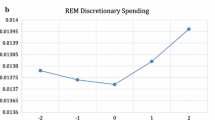Abstract
We investigate whether Jensen’s free cash flow problem contributes to excess stock return synchronicity. We find that low-growth firms with high free cash flow have greater stock return synchronicity. These firms also engage in earnings management to lower their disclosure quality. To the extent that free cash flow for low-growth firms provides corporate insiders an opportunity to extract private control benefit, our findings lend direct and concrete support to Jin and Myers (J Financ Econ, 79:257–292, 2006) prediction that insiders increase opaqueness to capture cash flow beyond the level expected by outsider investors. We identify Jensen’s free cash flow problem as an important driver for stock return synchronicity.
Similar content being viewed by others
Notes
Luo et al. (2014) find that foreign institutional investors in Japan increase stock price informativeness.
We thank the reviewer to point this out. Our results are qualitatively similar when FCF is scaled by total assets.
References
Bris A, Goetzmann W, Zhu N (2007) Efficiency and the bear: short sales and markets around the world. J Financ 62:1029–1079
Chen S, Fu K (2011) An examination of the free cash flow and information/signaling hypotheses using unexpected dividend changes inferred from option and stock prices: the case of regular dividend increases. Rev Pac Basin Financ Mark Polit 14:563–600
Chen S, Chung T, Chung L (2001) Investment opportunities, free cash flow and stock valuation effects of corporate investments: the case of Taiwanese investments in China. Rev Quant Financ Acc 16:299–310
Chen Q, Goldstein I, Jiang W (2007) Price informativeness and investment sensitivity to stock price. Rev Financ Stud 20:619–650
Chetty R, Saez E (2005) Dividend taxes and corporate behavior: evidence from the 2003 dividend tax cut. Q J Econ 120:791–833
Chetty R, Saez E (2006) The effects of the 2003 dividend tax cut on corporate behavior: interpreting the evidence. Am Econ Rev 96:124–129
Chirinko R, Schaller H (2004) A revealed preference approach to understanding corporate governance problems: evidence from Canada. J Financ Econ 74:181–206
Christie A, Zimmerman J (1994) Efficient and opportunistic choices of accounting procedures: corporate control contests. Acc Rev 69:539–566
DeAngelo H, DeAngelo L (2006) The irrelevance of the MM dividend irrelevance theorem. J Financ Econ 79:293–315
Dechow P, Sloan R, Sweeney A (1995) Detecting earnings management. Acc Rev 70:193–225
Desai M, Dharmapala D (2011) Dividend taxes and international portfolio choice. Rev Econ Stat 93:266–284
Durnev A, Morck R, Yeung B (2004) Value-enhancing capital budgeting and firm-specific stock return variation. J Financ 59:65–105
Fan J, Wong TJ (2002) Corporate ownership structure and the informativeness of accounting earnings in East Asia. J Acc Econ 22:401–425
Fernandes N, Ferreira MA (2009) Insider trading law and stock price informativeness. Rev Financ Stud 22:1845–1887
Ferreira MA, Laux P (2007) Corporate governance, idiosyncratic risk and information flow. J Financ 62:951–989
French K, Roll R (1986) Stock return variances: the arrival of information and the reaction of traders. J Financ Econ 17:5–26
Gangopadhyay P, Yook K, Shin Y (2013) Insider trading and firm-specific return volatility. Rev Quant Financ Acc. doi:10.1007/s11156-013-0362-z
Gaver JJ, Gaver KM (1993) Additional evidence on the association between the investment opportunity set and corporate financing, dividend and compensation policies. J Acc Econ 16:125–140
Haggard KS, Martin X, Pereira R (2008) Does voluntary disclosure improve stock price informativeness? Financ Manag 37:747–768
Hanson RC (1992) Tender offers and free cash flow: an empirical analysis. Financ Rev 27:185–209
Harvey C, Lins K, Roper A (2004) The effect of capital structure when expected agency costs are extreme. J Financ Econ 74:3–30
Healy PM, Palepu KG (1988) Earnings information conveyed by dividend initiations and omissions. J Financ Econ 21:149–176
Hutton AP, Marcus AJ, Tehranian M (2009) Opaque financial reporting, R2: and crash risk. J Financ Econ 94:67–86
Jensen M (1986) Agency costs of free cash flow, corporate finance, and takeovers. Am Econ Rev 76:323–329
Jin L, Myers SC (2006) R2 around the world: new theory and new tests. J Financ Econ 79:257–292
Lang L, Stulz R, Walkling R (1991) A test of the free cash flow hypothesis. J Financ Econ 29:315–355
Lehn K, Poulsen A (1989) Free cash flow and stockholder gains in going private transactions. J Financ 54:771–787
Luo M, Chen T, Yan I (2014) Price informativeness and institutional ownership: evidence from Japan. Rev Quant Financ Acc 42:627–651
Michaely R, Thaler RH, Womack K (1995) Price reactions to dividend initiations and omissions: overreaction or drift? J Financ 50:573–608
Morck R, Yeung B, Yu W (2000) The information content of stock markets: why do emerging markets have synchronous stock price movements? J Financ Econ 58:215–238
Piotroski J, Roulstone D (2004) The influence of analysts, institutional investors, and insiders on the incorporation of market, industry, and firm-specific information into stock prices. Acc Rev 79:1119–1151
Richardson S (2006) Overinvestment of free cash flow. Rev Acc Stud 11:159–189
Roll R (1988) R2. J Financ 43: 541–566
Skinner D (1993) The investment opportunity set and accounting procedure choice: preliminary evidence. J Acc Econ 16:407–445
Stulz R (1990) Managerial discretion and optimal financing policies. J Financ Econ 26:3–27
Veldkamp L (2006) Information markets and the co movement of asset prices. Rev Econ Stud 73:823–845
Wurgler J (2000) Financial markets and the allocation of capital. J Financ Econ 58:187–214
Author information
Authors and Affiliations
Corresponding author
Appendix 1
Rights and permissions
About this article
Cite this article
Cheung, W.M., Jiang, L. Does free cash flow problem contribute to excess stock return synchronicity?. Rev Quant Finan Acc 46, 123–140 (2016). https://doi.org/10.1007/s11156-014-0464-2
Published:
Issue Date:
DOI: https://doi.org/10.1007/s11156-014-0464-2




